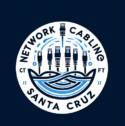What Is the Slowest Network Cable? Understanding Cable Speeds and Performance
When it comes to setting up a reliable network, the type of Ethernet cable you use makes a big difference. But have you ever wondered — what is the slowest network cable and why does it matter? Whether you’re upgrading your home internet or managing a business network, knowing the speed differences between cable types can help you make smarter decisions about your connections and performance. Our team of structured cabling experts in Santa Cruz ensures every installation meets top performance and safety standards.
What Are Network Cables Used For?
Network cables, also known as Ethernet cables, connect devices like computers, routers, switches, and servers so they can communicate and share data. These cables come in different categories (CATs), and each one supports a specific maximum speed and bandwidth.
From the early Cat3 to the ultra-fast Cat8, each category represents an improvement in speed, frequency, and shielding — but not all cables are created equal.
The Slowest Network Cable: CAT3
The slowest network cable still commonly known today is CAT3 (Category 3). Developed in the early 1990s, Cat3 was primarily designed for telephone lines and early Ethernet networks.
Here’s what you need to know about it:
- Maximum speed: Up to 10 Mbps
- Maximum frequency: 16 MHz
- Use case: Basic telephone systems and early 10BASE-T Ethernet
- Typical cable type: Unshielded twisted pair (UTP)
- Distance limit: Up to 100 meters (328 feet)
While it worked fine for basic voice and data applications decades ago, CAT3 cables are far too slow for modern internet use.
How Cat3 Compares to Newer Ethernet Cables
Let’s put things in perspective. Below is a comparison of different Ethernet categories and their top speeds:
| Cable Type | Maximum Speed | Maximum Frequency | Common Use Case |
|---|---|---|---|
| Cat3 | 10 Mbps | 16 MHz | Old telephone and legacy Ethernet |
| Cat5 | 100 Mbps | 100 MHz | Basic home networks |
| Cat5e | 1 Gbps | 100 MHz | Standard gigabit home/business networks |
| Cat6 | 10 Gbps (up to 55m) | 250 MHz | Modern business and residential |
| Cat6a | 10 Gbps | 500 MHz | High-performance enterprise networks |
| Cat7 | 10+ Gbps | 600 MHz | Data centers, shielded networks |
| Cat8 | 25–40 Gbps | 2000 MHz | Professional data centers and servers |
As you can see, Cat3 is the slowest, and cables from Cat5 and above have drastically improved in speed and reliability.
Why Using Slow Cables Can Hurt Your Network
Using older or low-performance network cables can cause several problems:
- Slower internet speeds even if your ISP provides high bandwidth
- Frequent connection drops or lag when streaming or gaming
- Data bottlenecks in office networks with multiple users
- Higher interference and signal loss over distance
Even if your devices are modern, your network is only as fast as its weakest link — meaning a Cat3 or Cat5 cable could be holding everything back.
How to Tell Which Cable You Have
Most Ethernet cables are labeled along their outer jacket (for example, “Cat5e” or “Cat6a”). If you can’t find the label, the thickness and build can also give a clue:
- Cat3 and Cat5 cables are thinner and often unshielded
- Cat6 and above are thicker and have more twists or shielding to reduce interference
If you find an old Cat3 cable in your setup, it’s definitely time to upgrade.
Recommended Cable Upgrades
For most users in California and across the U.S., here’s what to choose instead:
- Cat5e – Great for basic home or small business setups (1 Gbps speeds)
- Cat6 – Perfect for modern homes and offices with high-speed internet
- Cat6a or higher – Ideal for heavy data use, streaming, or security systems
When upgrading, make sure to hire a professional network cabling installer who can properly route, terminate, and test your cables for maximum performance.
The Bottom Line
The slowest network cable still in existence is CAT3, limited to 10 Mbps. While it once powered early Ethernet networks, it’s now outdated for today’s fast internet demands. While some cables limit data transfer rates, others can reach far higher capacities — find out the maximum speed of a network cable to see how each type compares.
Upgrading to at least Cat6 or Cat6a ensures faster speeds, fewer issues, and long-term compatibility with future technologies.
If you’re unsure what cables your property uses, consider scheduling a professional network assessment — a small step that can make a big difference in your connectivity.
